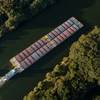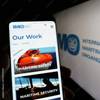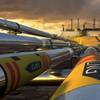Bay Area members of Congress suggested that tougher safeguards might be needed on cargo ships to prevent accidents like the recent Cosco Busan spill that resulted in 58,000 gallons of heavy bunker fuel in San Francisco Bay.
One possibility would be to require double-skins on fuel tanks or some sort of partial double hull on cargo ships. In response to the disastrous Exxon Valdez spill in Alaska in 1989, all oil tankers in U.S. waters must have double hulls by 2015.
Another would be to make the Coast Guard's vessel transport system more stringent for ships entering and leaving ports, like the air traffic control system.
Though the Cosco Busan did not have a double hull, it did have an added layer of safety: a tugboat, which is required in the Bay under state law for oil tankers, but not cargo ships, was attached to the ship at the time of the accident.
The tug escort can push or pull ships away from trouble if they lose power, lose steering or have other problems.
Yet despite that precaution, the tugboat apparently was not asked — or may have been unable — to steer the vessel clear of the collision in time.
With the cause of the accident still a mystery, the fact that the tug was not able to save the ship could indicate that the pilot and crew did not realize the ship was dangerously off course, experts familiar with the case reportedly indicated.
Cargo ships and chemical tankers are not required to have tug escorts. But larger cargo ships often do when they leave the Port of Oakland to help them stay in the narrow shipping channel between Oakland and the Bay Bridge, said Commodore John Keever of the U.S. Maritime Service.
Called Revolution, the tugboat roped to the stern of the Cosco Busan was built only two years ago and is one of the strongest tugboats in San Francisco Bay with 5,000 horsepower.
It is owned by AmNav Maritime Services, an Oakland company.
Meanwhile, the Coast Guard has detained the Cosco Busan because of the gash in its hull and an unspecified deficiency with the ship's crew.
The investigation into the spill is ongoing.
The Coast Guard said the ship's crew was in San Francisco Bay for the first time but found no problems with the vessel itself.
Reportedly, the Coast Guard has asked the National Transportation Safety Board to determine the cause of the spill in order to remove the perception the Coast Guard was investigating itself.
The U.S. Attorney's Office is investigating whether civil penalties or a criminal prosecution are warranted. Hearings are also expected in Congress and in the state Legislature.
The Coast Guard has been criticized for initially underestimating the size of the spill at only 140 gallons and for being slow to alert local government officials and the public once it knew the spill had grown to 58,000 gallons. Of that amount, 12,270 gallons have been recovered.
The spill occurred when the Cosco Busan was leaving the Port of Oakland bound for South Korea when it struck the Bay Bridge, opening up a gash nearly 100 feet long on a ship that is the length of three football fields.
More than two dozen beaches, including popular destinations such as Stinson Beach, Muir Beach and Angel Island, remain closed. Point Isabel and a coastal access point in Point Richmond were closed in Contra Costa.
Cleanup officials said very little recoverable oil remains on the water and that their efforts began shifting from cleaning up the water to cleaning up the shore.
The Coast Guard is reportedly preparing to release recordings and transcripts of radio transmissions to and from the ship, but those materials were being reviewed prior to release. [Source: http://www.insidebayarea.com]
Subscribe for
Maritime Reporter E-News
Maritime Reporter E-News is the maritime industry's largest circulation and most authoritative ENews Service, delivered to your Email five times per week










